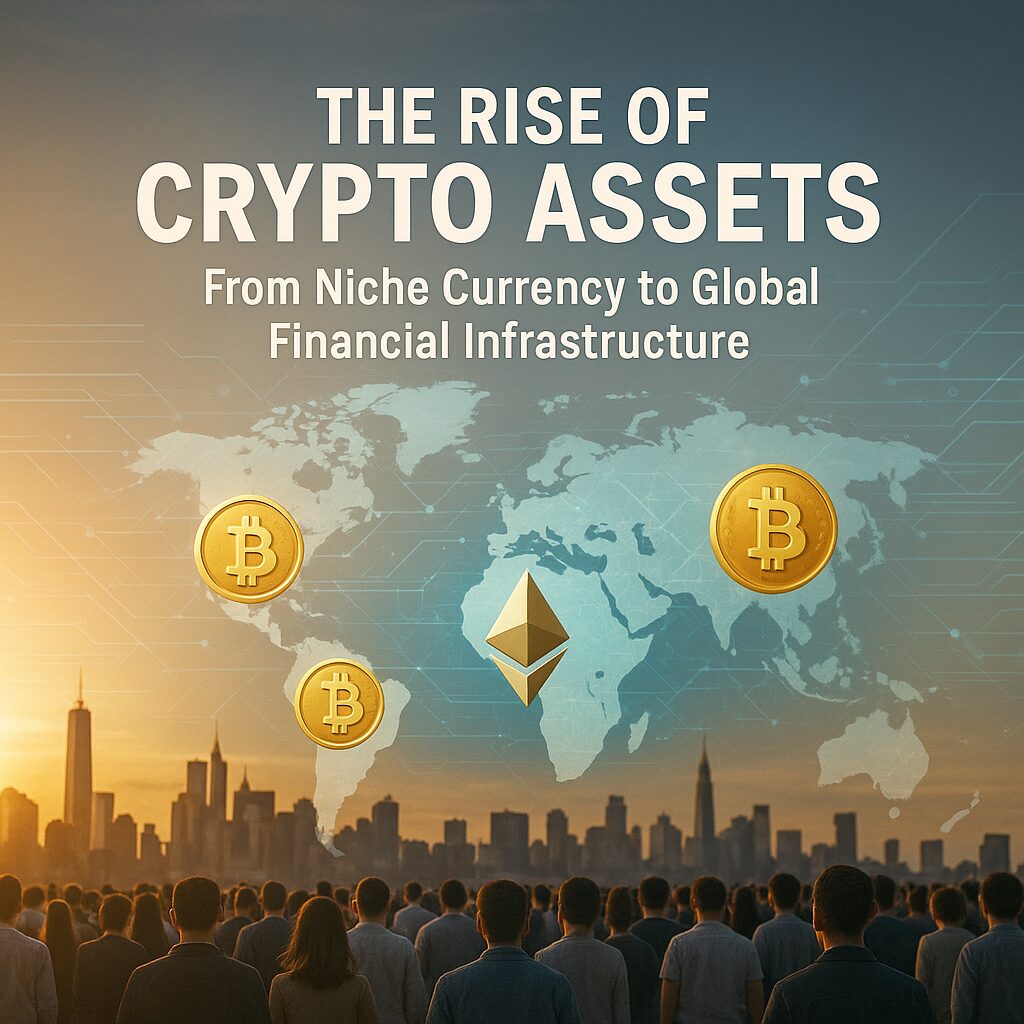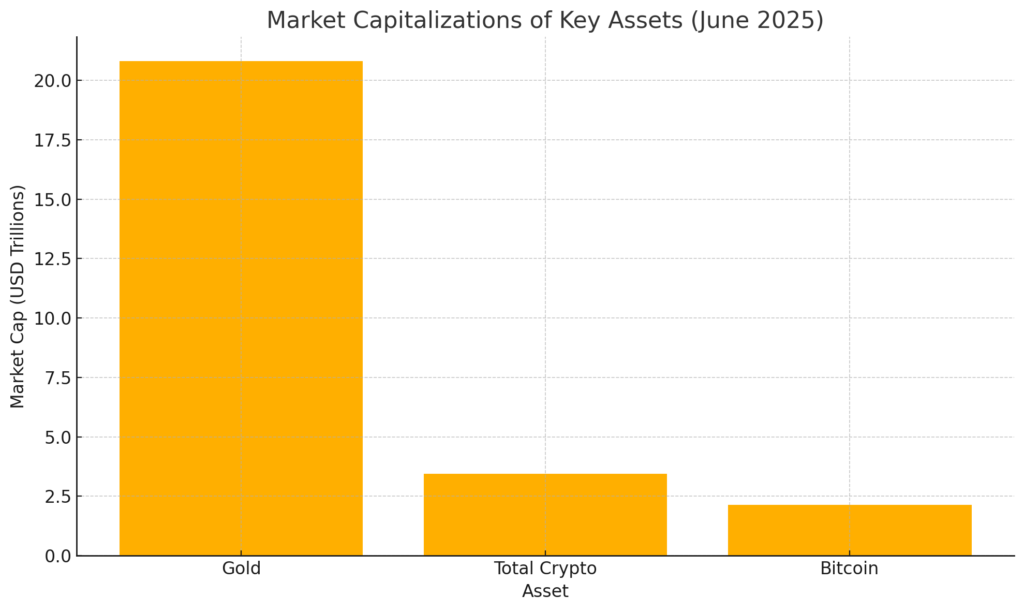
Key Takeaways :
- Crypto assets have evolved from experimental digital money into a multi-trillion-dollar ecosystem with over 700 million users worldwide.
- Institutional adoption and regulated investment vehicles (e.g., Bitcoin spot ETFs) have driven legitimacy and inflows—BlackRock’s IBIT ETF alone holds $74.2 billion.
- Decentralized networks (blockchains) enable trustless, programmable money without central intermediaries—empowering use cases from payments to smart contracts.
- National strategies are emerging: the U.S. established a Strategic Bitcoin Reserve; the EU’s MiCA regulation is fully in force; Japan advances tax reform and exchange licensing.
- As programmable finance matures, crypto assets are reshaping global payment rails, reserve portfolios, and monetary sovereignty.
Part 1: How Widespread Are Crypto Assets Today?
Explosive Market Growth
- Bitcoin’s Market Cap
As of June 29, 2025, Bitcoin’s market capitalization stands at $2.136 trillion—nearly 14 % of gold’s market value despite existing only since 2009. - Total Crypto Ecosystem
The combined crypto market reached $3.45 trillion by late June 2025, reflecting 42 % growth year-on-year. - Global User Base
An estimated 700 million individuals hold or transact crypto assets—up from roughly 275 million in 2020 (163 % CAGR) according to Crypto.com estimates.
Visualization:
Below is a comparison of market capitalizations for gold, the entire crypto market, and Bitcoin.
.

- Corporate Reserves
Over 85 publicly traded companies now hold more than 800 000 BTC (≈$86 billion)—MicroStrategy leads with 582 000 BTC on its balance sheet. - Government Strategies
- United States: In March 2025, President Trump signed Executive Order 14233 establishing a Strategic Bitcoin Reserve and Digital Asset Stockpile, formalizing BTC as a sovereign reserve asset.
- European Union: The Markets in Crypto-Assets Regulation (MiCA) entered fully into application on December 30, 2024, standardizing licensing and disclosures for service providers across all member states.
- Japan: Ongoing tax reforms aim to introduce separate 20 % capital gains tax on crypto, enable loss carry-forward, and pave the way for domestic Bitcoin ETFs by 2026.
Part 2: Under the Hood—Why Decentralized Money Works
Blockchain Fundamentals
- Distributed Ledger
A blockchain is a shared, append-only ledger maintained by nodes worldwide. No single entity controls transaction validation—security emerges from network consensus. - Consensus Mechanisms Algorithm Description Examples Proof of Work (PoW) Nodes solve computational puzzles to propose blocks (energy-heavy) Bitcoin, Litecoin Proof of Stake (PoS) Validators are chosen proportionally to their stake (energy-efficient) Ethereum, Solana Byzantine Fault Tolerance (BFT) Permissioned nodes vote to confirm blocks (fast, but less decentralized) XRP, Polkadot, Stellar
- Supply Schedules
Fixed issuance models (e.g., Bitcoin’s 21 million cap with halving every 4 years) ensure predictable, deflationary supply curves, contrasting with elastic fiat issuance.
Beyond Currency: Programmable Finance
- Smart Contracts & DeFi
Platforms like Ethereum enable self-executing contracts—tokenization, lending protocols, decentralized exchanges, and NFTs operate seamlessly without intermediaries. - Stablecoins & Payments
Dollar-pegged tokens (USDC, USDT) facilitate low-cost cross-border remittances, especially in emerging markets. Visa and Mastercard now support direct stablecoin payments via card rails.
Part 3: Crypto Assets in the New Financial Order
Monetary Sovereignty & Reserves
- Digital Gold
Nations under sanctions or facing fiat volatility view Bitcoin as a hedge: Russia and China have trialled BTC-settled energy trades. - Strategic Reserve
The U.S. reserve formalization signals treating crypto as sovereign infrastructure—analogous to gold reserves—with policies for acquisition, custody, and compliance.
Regulatory Balancing Act
- U.S. Policy Shift
EO 14178 (Jan 23, 2025) declared digital assets critical for economic growth, tasking Treasury and Commerce to foster leadership in blockchain innovation. - EU’s Comprehensive Framework
MiCA mandates capital requirements, white-paper disclosures, and authorizations, elevating investor protection and market integrity. - Asia’s Next Steps
Japan’s move toward ETFs and softer taxation aims to repatriate crypto startups and trading volumes, strengthening its Web3 strategy.
Conclusion
Crypto assets have transcended their early reputation as speculative “virtual currencies.” Today, they form an expansive, multi-trillion-dollar web of financial infrastructure—encompassing stores of value, programmable money, and alternative reserve assets. Institutional vehicles like ETFs, sovereign strategies such as the U.S. Strategic Bitcoin Reserve, and harmonized regulations under MiCA are ushering crypto assets into mainstream finance.
For those seeking new investment opportunities or practical blockchain applications, the time to engage is now. Start small: acquire a modest amount of Bitcoin or stablecoins, experiment with payments or DeFi protocols, and deepen your understanding. As the financial landscape evolves, crypto assets will offer not only speculative upside but also firsthand lessons in monetary innovation and global asset diversification.

